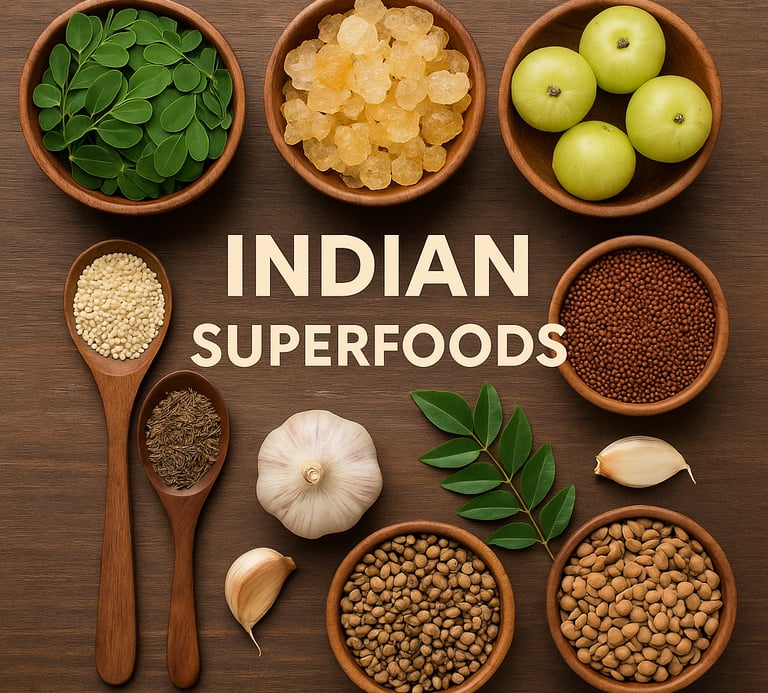Indian Superfoods You Probably Ignore But Shouldn't
In a world obsessed with quinoa, kale, and chia seeds, it's easy to forget that India is a treasure trove of nutrient-dense, healing, and affordable superfoods. Often hiding in plain sight — in our kitchens, markets, and even temple offerings — these traditional foods offer potent health benefits rooted in both Ayurveda and modern nutritional science. Let's rediscover the Indian superfoods you might be overlooking and why they deserve a permanent spot in your plate.
NUTRITION
5/28/20252 min read


Indian Superfoods You Probably Ignore But Shouldn't
In a world obsessed with quinoa, kale, and chia seeds, it's easy to forget that India is a treasure trove of nutrient-dense, healing, and affordable superfoods. Often hiding in plain sight — in our kitchens, markets, and even temple offerings — these traditional foods offer potent health benefits rooted in both Ayurveda and modern nutritional science. Let's rediscover the Indian superfoods you might be overlooking and why they deserve a permanent spot in your plate.
🌾 1. Moringa (Drumstick Leaves)
Why it’s super: Packed with iron, calcium, vitamin C, and antioxidants
Benefits: Fights inflammation, boosts immunity, enhances energy
How to use: Add to dals, stir-fries, soups, or make moringa chutney
🌱 Ayurvedic Wisdom: Known as Shigru, it's used to balance Vata and Kapha doshas.
🌰 2. Gond (Edible Gum)
Why it’s super: High in collagen-building compounds, supports joints and postpartum recovery
Benefits: Strengthens bones, promotes skin health, improves stamina
How to use: Popular in winter laddoos (e.g., gondh ke laddoo)
🧘 Ideal for people over 40, women post-delivery, or those with joint issues.
🍇 3. Amla (Indian Gooseberry)
Why it’s super: Contains 20x more Vitamin C than oranges, powerful antioxidant
Benefits: Boosts immunity, supports digestion, controls blood sugar
How to use: Eat raw with salt, pickle it, or take as murabba or amla powder
🧪 Modern Proof: Shown to reduce oxidative stress and support cholesterol balance.
🌾 4. Ragi (Finger Millet)
Why it’s super: Rich in calcium, iron, fiber, and amino acids
Benefits: Strengthens bones, controls blood sugar, keeps you full
How to use: Make ragi dosa, porridge, or even ragi-based cookies
🍽️ Gluten-free and excellent for growing children, diabetics, and seniors.
🍂 5. Curry Leaves
Why it’s super: More than just a tempering agent — loaded with iron, folate, and vitamin A
Benefits: Improves hemoglobin, digestion, and hair health
How to use: Chew raw in the morning or powder them into chutneys and spice mixes
🌿 Tip: Make dry curry leaf chutney powder to sprinkle on rice or rotis.
🫘 6. Horse Gram (Kulthi Dal)
Why it’s super: India’s most protein-rich lentil with excellent thermogenic properties
Benefits: Supports fat loss, kidney health, and metabolism
How to use: Kulthi rasam, sundal, or sprouted horse gram salads
🔥 Traditionally used in winters and for weight management in Ayurveda.
🌻 7. Sesame Seeds (Til)
Why it’s super: Dense in healthy fats, calcium, zinc, and fiber
Benefits: Supports heart health, skin glow, and hormonal balance
How to use: Til laddoos, dry chutney powders, til oil in cooking
🕯️ Commonly used during Makar Sankranti for its warming properties.
🧄 8. Raw Garlic (Lasun)
Why it’s super: Natural antibiotic and anti-inflammatory powerhouse
Benefits: Supports heart health, lowers cholesterol, strengthens immunity
How to use: Chew a clove with warm water in the morning or use in chutneys
⚠️ Best eaten raw on an empty stomach for medicinal benefit.
🍵 9. Ajwain (Carom Seeds)
Why it’s super: Digestive stimulant and anti-flatulent
Benefits: Relieves bloating, menstrual pain, and boosts metabolism
How to use: Chew raw, make ajwain water, or add to paratha dough
🧂 Excellent post-heavy meal remedy, often combined with kala namak.
✅ Conclusion: Superfood, Desi-Style
India’s superfoods aren’t flown from faraway lands — they’re grown in your backyard, sold by your sabziwala, and passed down through grandma’s recipes. Reclaiming these nutrient-rich ingredients not only supports your health but also promotes local farming, traditional knowledge, and seasonal eating.
Start simple: one new food each week. Watch your energy, immunity, and wellness thrive — the Indian way.
Follow us
platanoorganic6@gmail.com
+919019754079
© 2025. All rights reserved.
FSSAI License no : 21223192000415
Platano Organic Foods
